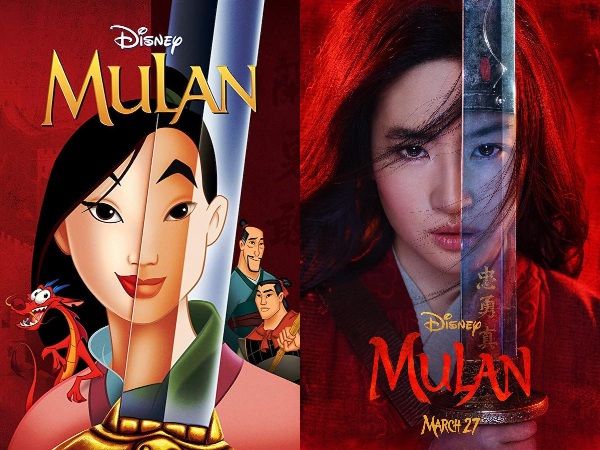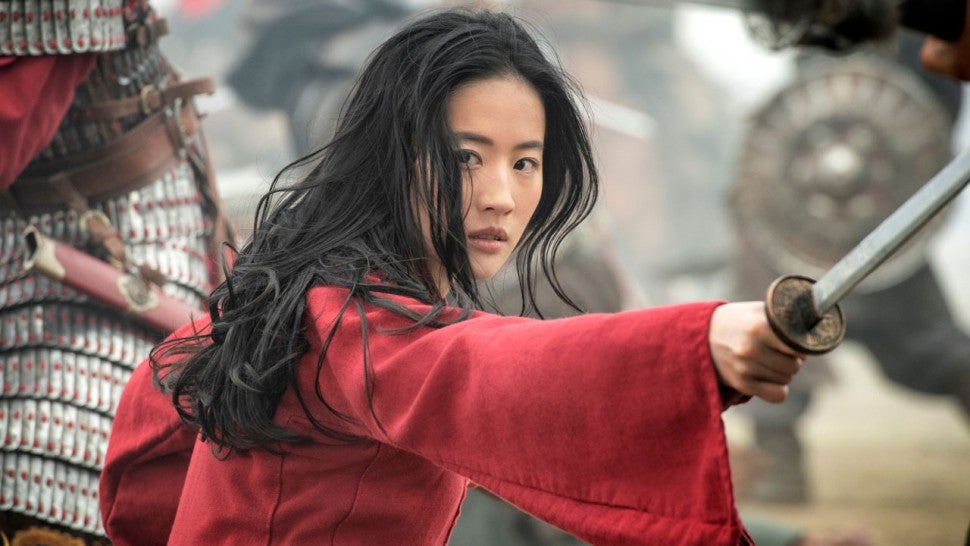The premiere of Disney’s live-action Mulan (2020) has sparked many heated debates, even since before it premiered. For fans of Disney’s other live-action princess films, such as Cinderella (2015) or Beauty and the Beast (2017), they should be expecting something entirely different. Director Niki Caro took a lot of creative liberties with the live action by making it really full of live “action”, granted that the filmmakers were given a lot of creativity to work with the sixth century poem of a girl who disguises herself as a boy to join the Chinese Imperial Army to save her father from going to battle, which the story of Mulan is based on. This new tale of Mulan has been reimagined, far from a recreation of the animated version released 22 years ago, into a fantasy action film with an overwhelming amount of controversy and changes that were not beneficial to the story.

Liu Yifei as Mulan, courtesy of Disney.
Disney’s latest live-action venture is not one without risks and debate. Prior to its release, main actress Liu Yifei’s commented on the pro-democracy protest in Hong Kong in August 2019, where she showed support for the Hong Kong police. The public took these comments as her supporting police-brutality and the China Communist Party, due to their excessive use of force during the protest. This sparked the Twitter hashtag #BoycottMulan as Liu Yifei was faced with backlash from the public. After its release was delayed due to the ongoing pandemic, Mulan premiered on Disney+ on September 4, 2020 with an additional Premiere Access price of $29.99 USD on top of the monthly subscription fee of $7.99 USD. This unprecedented release only fed into further boycott, as the public accused Disney of being money hungry. Now, new protests have surged as it was reported that Mulan was partly filmed in Xinjiang, where Uighur Muslims have been imprisoned in concentration camps. However, Disney has reported that these protests did not affect Disney+ subscriptions negatively, as subscription sign ups shot up in the past weekend since the release of Mulan.
With the rise of the gender-equality movement in Hollywood and the mandate for more Asian representation following films like Crazy Rich Asians (2018) and The Farewell (2019), it would seem like the release of Mulan (2020) would be timely and yearned for. New Zealand director Niki Caro is the second woman and New Zealander to be hired by Disney to direct a film with more than a $100 million budget. With a $200 million budget, Mulan is the most expensive film ever made by a female director. Though Mulan did not have a lot of Asian people working behind-the-scenes, it is a game-changer for female filmmakers as Caro had a production team that included a female producer, female first assistant director, and female director of photography. She was proud that filmmaking of this live-action’s scale was achieved by women in senior roles and that everything was well-communicated, production delivered on time, and was slightly under budget.

1998 Mulan and 2020 live-action Mulan, courtesy of Disney.
However, fans of the animated version of Mulan (1998) would be sorely disappointed as this is not a remake of the animated version. Heavy creative changes were made to make this version its own, including the scandalous decision to remove the animation’s musical numbers and beloved characters, like comic-relief Mushu and love-interest Li Shang. Disney defends these choices as Mushu was eliminated due to the need of Mulan to bond with the other soldiers. In the case of Li Shang, Producer Jason Reed says Li Shang was excluded because of the #MeToo movement, and it did not seem appropriate to have a commanding officer as a love-interest. Many have criticized this change and further accused Disney of being anti-LGBTQ.
The screenplay of Mulan was highly criticized as well with mostly negative reviews. The storyline was altered from Disney’s romanticized animation to one that is, actually, closer to its origins. The story and dialogue were westernized for the audience, which is understandable as that is their main target audience. Anyone who wants to watch the story of Mulan produced in Chinese can watch Mulan: Rise of a Warrior, which was released in 2009. The screenplay of Disney’s live-action Mulan had potholes and under-developed character arcs that make it difficult for audiences to connect with its characters. Like most Disney legends and fairytales, there were elements that were fantasized and changed to appeal to Disney audiences. It would also seem that the scriptwriters received inspiration from other more famed fantasy films, like Star Wars, most likely hoping to make it appeal to the fanbase.

Character posters, courtesy of Disney.
One feature from the animation that received an upgrade were the action sequences. The live-action’s cinematography and visuals received praise and are the true highlight of the film. Caro seems to use wuxia films as her muse, which is a genre of Chinese fiction that sometimes contains gravity-defying martial art sequences. One can see similarities in Mulan and other well-known wuxia films such as Crouching Tiger, Hidden Dragon (2000) and Hero (2002). Mulan has even attracted renowned Chinese legends such as Jet Li (The Forbidden Kingdom 2008, The Expendables franchise) and Donnie Yen (Rogue One: A Star Wars Story 2016, Ip Man franchise), both of whom also worked together in Hero (2002). The action scenes are the reason Mulan has now been dubbed the new “Asian Matrix”.
At the very beginning of the film, the narrator already points out that this story is its own, separate story from any other versions. Despite its overwhelming amount of controversies, one should try watching the film, if only for the viewing experience. Though it is not the same as the animated version, it’s important to note that both the animated and live-action films have historical inaccuracies, and the animated version had details that upset certain audiences too. This Westernized Mulan script is imperfect, but its action scenes pay homage to wuxia kung fu films, making it worthwhile to watch – mainly as an action film. But in the end, I would add Mulan to the list of Disney films, such as Aladdin (2019) and The Lion King (2019), that failed to live up to public and critic expectations.


Recent Comments